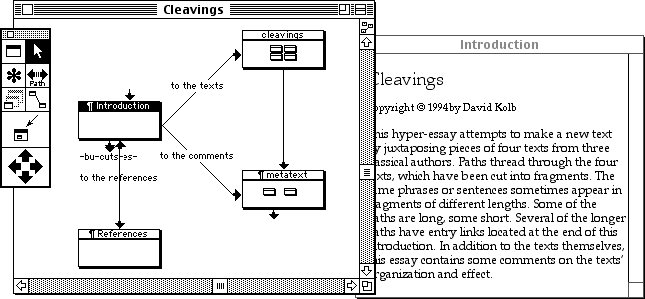Storyspace (cf. 2.1.11) was developed in 1990 by Mark Bernstein. It was initially released for Macintosh only, but a port to Windows also exists. Storyspace is much better suited for writing and reading hypertext than HyperCard is, in that it supports text links rather than just rectangular areas on top of the text layer, that need to be updated if the text underneath moves. Hyperlinks do not have to be coded, they are created and directly manipulated with the mouse.
Several scientific texts have been written with Storyspace, because the diagram mode visually reveals the logical structure of arguments. Poets use it to write interactive fiction and poems. This is remarkable as non-technicians consort with the field of computer hypertext for the first time.
2.1.11 Storyspace
in Vision and Reality of Hypertext and Graphical User Interfaces
Michael Joyce wrote the first electronic hypertext novel Afternoon, a story with Storyspace in 1990 [Joyce 92]. It is composed of 539 nodes and more than 900 links. Afternoon is an established classic in the new literary genre of hypertext fiction. Michael Joyce is also, together with Mark Bernstein, co-developer of Storyspace. The discussion in this section is based on his paper Storyspace as a hypertext system for writers and readers of varying ability [Joyce 91]. Another source is the user manual Getting Started with Storyspace for Macintosh 1.5 [Bolter et al. 96].

Fig. 2.11 The main writing space for the Storyspace hyperdocument “Cleavings” contains four writing spaces. Two of them contain writing spaces on themselves. The second window shows the text space of the “Introduction” node.
A hypertext in Storyspace consists of a network of writing spaces. A writing space has a title, a text space and furthermore a topographic space. For the main writing space just this last mentioned space is used to spatially arrange the nodes of the hypertext that are for their part again writing spaces. The enfolded writing spaces offer the same functionality as the top level space. This leads to a recursive segmentation of the entire hypertext graph. Nonetheless this approach does not constrain the graph to a tree structure, because nodes inside a writing space can link to any other writing space, no matter whether it resides in the same writing space or not. It is rather motivated by the same idea as Frank Halasz’ composites are. It offers an additional dimension to classify the nodes of an hypertext. It supports the user in creating different levels of abstraction of the topic and in keeping the structures handy. In accordance with Halasz it is also possible to refer to an entire writing space by hyperlinking.
If also the starting point of a link is a writing space the link is called basic. These basic links have no representation in the text space. A special button in the tool bar – the Navigate tool – is needed to follow basic links.
The other component of writing spaces is the text space. It contains a standard text editor with basic layout capabilities. Images can be placed into the flow of text. Text links are created for the current selection with a menu command. This provokes a line to be drawn between the origin of the link and the position of the mouse cursor until the user clicks a target [Müller-Prove 99].
Links are not highlighted. They do not distinguish from the rest of the text until the reader presses the OPTION-CMD keys. Then the links get surrounded by a solid frame and can be clicked to jump to the target writing space. In Afternoon, where nearly every word is a hyperlink, a double click is used instead of the modifier keys.
A peculiarity in Storyspace is that links can point to several targets at the same time. On activating such a link marker a modal dialog presents the descriptions for all links in question. It is also possible to attach conditions to links. For example a condition can be set up to only activate the link if a specific node has been visited before.
![]() For a free PDF version of Vision and Reality of Hypertext and Graphical User Interfaces (122 pages), send an e-mail to:
For a free PDF version of Vision and Reality of Hypertext and Graphical User Interfaces (122 pages), send an e-mail to:
![]() mprove@acm.org I’ll usually respond within 12 hours. [privacy policy]
mprove@acm.org I’ll usually respond within 12 hours. [privacy policy]